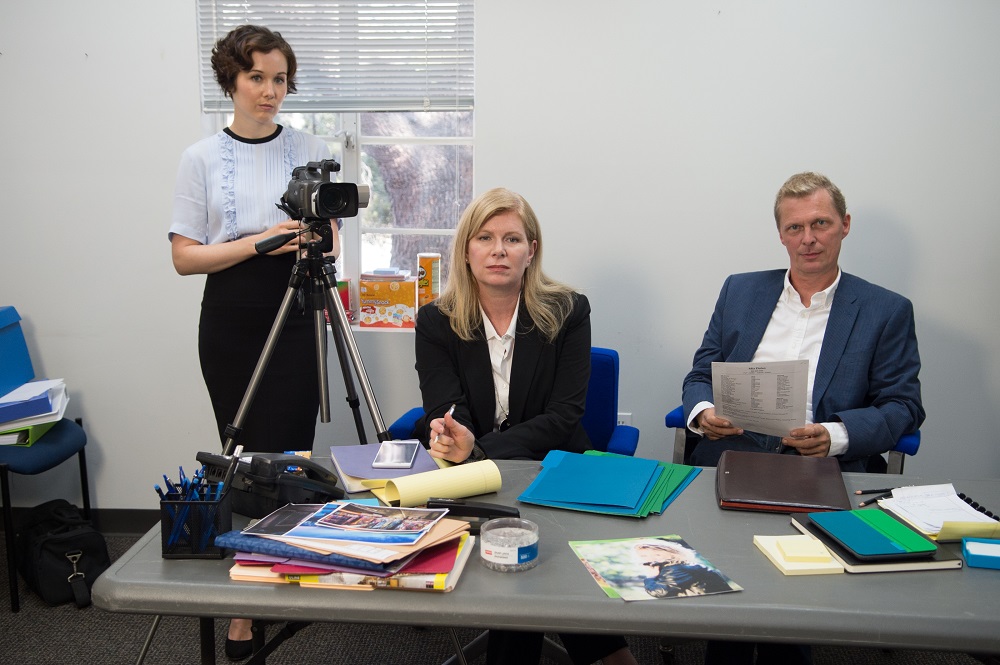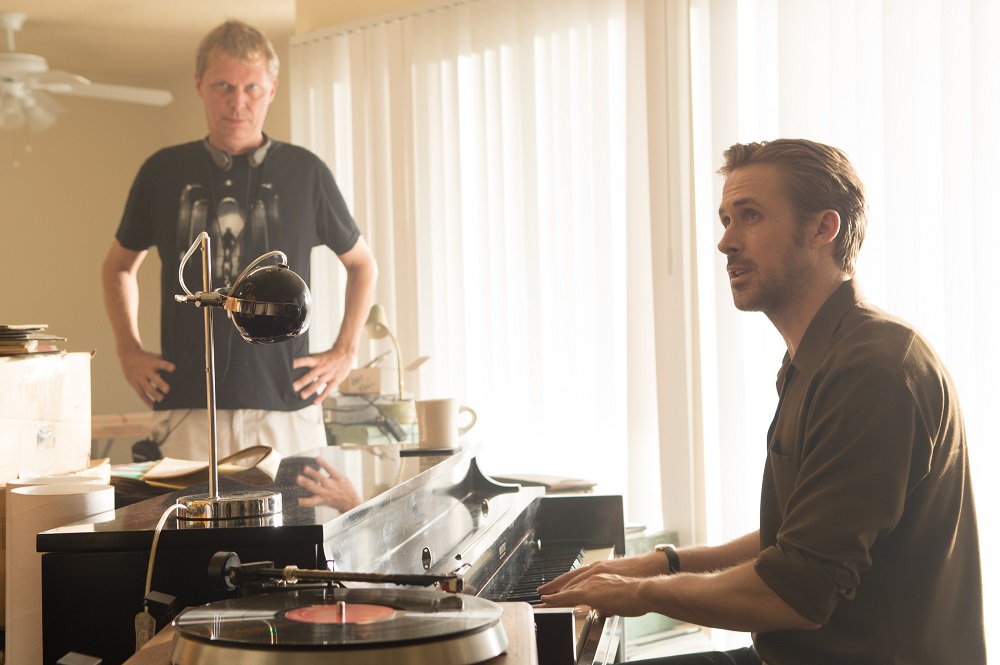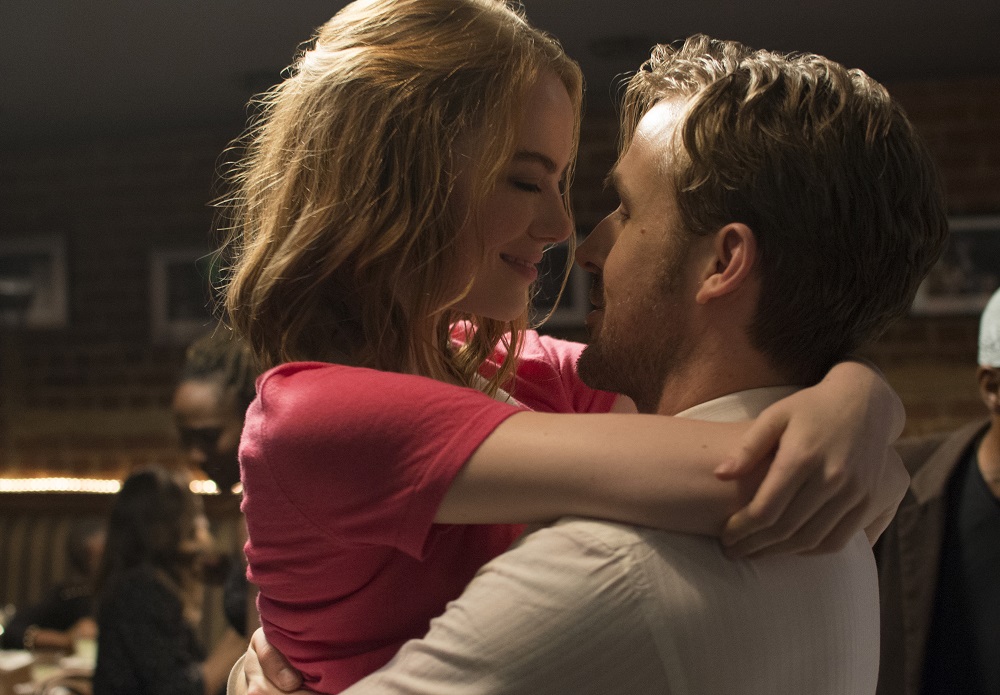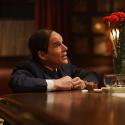La La Land needs no further introduction. A homage to the golden age of the movie musical, to Michel Legrand and The Umbrellas of Cherbourg, it contains perhaps the catchiest score to come out of Hollywood in many years. Unless you have a heart of reinforced teak, its silk-and-honey songbook will seep into your consciousness and stay there, from the rapturous overture “Another Day of Sun” via Mia’s beautiful song “Audition” and the perky love duet “Lovely Night” all the way through to Mia and Sebastian’s bitter-sweet theme tune.
The film is the college dream of director Damien Chazelle and composer Justin Hurwitz. In awards season, their names will be written in the stars alongside those of Emma Stone and Ryan Gosling. But such a vast musical undertaking doesn’t happen without someone taking charge. That person was Marcus de Vries, 55, the British music producer whose bulging CV includes not just major collaborations with Björk and Rufus Wainwright but also, more pertinently for La La Land, two films with Baz Luhrmann. De Vries composed the score for Romeo + Juliet with Nellee Hooper, and was the music director on Moulin Rouge!
I became the man with one eye in the country of the blind
But music director and executive music producer weren't quite his only roles on the film: he also has a cameo on screen as a lofty casting director dismissing Mia in an audition (pictured below). He tells theartsdesk exactly how the extraordinary score came into being, from the songs themselves to the film's lush orchestral backing, the role of jazz musician John Legend and, above all, the musical performances of its stars. No faking was involved, so how on earth did de Vries turn a keyboard novice into an intense jazz soloist?
 JASPER REES: Could you begin at the beginning and talk about when you came in, and what the job was?
JASPER REES: Could you begin at the beginning and talk about when you came in, and what the job was?
MARIUS DE VRIES: This movie was conceived and to a large extent written before Whiplash but it was only after Damien hit that home run that the resources were available to make the idea into a reality. You can make a film like this with a sense of frugality but you can’t make it cheap. This was getting on for three years ago and that was the point at which they called me because, for all of the detail in which conceptually the thing had been envisaged, no one at the studio or on the creative team had ever actually made a musical at this level before. And I have made a few, so in a narrow tehnical perspective I became the man with one eye in the country of the blind.
One of the first things that needed to happen was a very, very strong music development to be built around a set of existing compositions that were melodically very strong, but there was very little depth of wisdom in how you take a strong script and some great melodies and shoot it. It became a daily process and was pretty much full time from then on.
What was the first hurdle to clear?
The biggest immediate problem was that we had no words, and a song doesn’t exist until it has words. The initial challenge, and this involved going back to the drawing-board on some songs, was to find the right people to help us find a lyrical language that was poetic enough, that was unfussy enough to fit with the naturalism we were going for, and craftsmanlike enough to do what theatrical lyrics do, which is continue to tell a story, so that musical numbers aren’t just pauses in the narrative. And we were very lucky to come across Justin Paul and Benj Pasek. One of the difficulties for them was that the melodies were written and there wasn’t an awful lot of flexibility to accommodate the words. So it was an enormous crossword puzzle as well as a challenge of poetry writing.
How easy was it for Justin Hurwitz to orchestrate his own score never having done so before?
Hollywood is all about precedent. People would ask, “At what point are you going to start getting someone to orchestrate this?” Now, Justin's orchestrations were well under way and already pretty much at genius level, so I felt it was an unwritten part of my employment that it was my task to nurture and protect that process against all of the things that might happen to it under the scrutiny of outsiders. Everyone, especially in those early stages when everything is plastic and malleable, has an opinion about what you should do, and it’s normally just based on looking at other things that you could vaguely compare this project to and say, “Well, why don’t we do that?” Because of my background with a movie like Moulin Rouge! I would be asked all the time, “Where is our Lady Marmalade?” (see video below). And when we were going to get the superstars in to start performing songs? Just because that worked last time, according to the logic of Hollywood that has to work this time. You can’t simply fold your arms and say, “No, we’re not going to do that.” So there’s a large amount of politics and frankly manipulation that has to go on just to keep people’s trust at a high level but at the same time to buy the freedom and the space that you need for a complicated undertaking like this to be able to grow.
Having said all that, I have to applaud Lionsgate for their overall support for the movie - beneath all the discussions we had, they showed an amazing amount of trust and faith in the project. Obviously it could never have been made without their support and courage - and they should be massively congratulated for this.
How musical did the two leads need to be?
They both in different ways have a high level of musicality. That was definitely, to say the least, an advantage. Much as the music department screamed and begged, I’m sure Damien’s final decision was based on finding the right actors to inhabit these characters and everything else would be figured out. Which is generally the way.
How did you take their measure?
With Emma I went to see Cabaret a couple of times, not only to get a sense of how she was as a singer but also to get an idea of what keys she was likely to be comfortable in. But nothing is a substitute for finally getting in a room. We booked a room with a piano and Justin and Emma and I sat there and we just sang through some melodies. At that point it’s not an audition. It’s a beginning of a crucial process of establishing rapport and trust. Then they have to come in and do all sorts of things which are intrinsically uncomfortable. No matter how experienced an actor is in front of a camera, it’s always initially a very confronting thing to attempt to communicate in song. And the level of scrutiny when there’s a microphone two inches from your face, or later a camera, initially feels very invasive.
Ryan Gosling’s pianism is impressive. How did you get him to that level? (De Vries and Gosling pictured below)
Isn’t that amazing? Ryan by his own confession was at most a beginner. I knew that whoever we found it was going to be a challenge. That’s an understatement. A central tenet of the character is a level of virtuosity that needs to be astonishing. I found a wonderful piano teacher called Liz Kinnon who works at the Colburn, a music school in Downtown Los Angeles. It was serendipitous. I’d previously found her to give lessons to a friend of mine. I knew that she had the right kind of temperament. I introduced her to Ryan. They just clicked from the get-go. They found a very deep level of trust and reliance upon each other. Liz sat with him for two hours a day for four months and then sat with him throughout every take and just got him to where he needed to be. It was very important to Ryan that he understood what he was doing and not just give a passable physical account of it. We were nervous right up until the minute the camera rolled on the second day of the shoot. It was a scheduling accident that it happened to be one of his biggest piano solo moments. I remember they wrapped the very first shot. Before the applause broke out there was 10 or 15 seconds of stunned silence in the room.
 Which piece was it?
Which piece was it?
It was that first big piano piece he plays when he sabotages the Christmas carol with melodic and then furious jazz off his own invention and then gets fired.
To what extent was it felt to be necessary to record the singing takes live?
The obstacles were a long list of technical and psychological challenges that had to be surmounted. You’re making pictures, so you’re severely limited. You stick microphones in the hairline and the clothes, sometimes put an earpiece in but even that is problematic. Plus it’s really hard to lock down a set to the extent that you can record a clean vocal. Not to mention that you have no control over the space. And when it’s a close-up you can put the microphone in closer but when it’s not you have to pull the microphone away so everything you try to teach people about microphone technique and keeping your head in a stable position goes out the window. You really do create a massive stick to beat yourself with.
 But the gain…?
But the gain…?
The reason you do it, and I discovered this way back on Moulin Rouge!, is that you get way ahead of the problem of that membrane between dialogue and song being a jump in perception. It makes that so much more seamless. It makes the stakes of the visual performance so much higher because it is palpably married to what is happening to the mouth in the way that the best lip-syncers in the world cannot fully mimic. I think you can trick the eye but you can’t trick the soul. There is no substitute for the naturalism and the believability and the emotional truth that you get when you go to all that trouble to record the vocal line.
How important was it that La La Land harked back to the golden age of the Hollywood musical?
For sure it’s informed with a love and respect for that craft. Shooting in Hollywood the shadows of those classics were very perceptible and very important to us. But at the same time we were extremely conscious of the fact that we wanted a heartfelt homage to that form but not to be enslaved by it, and to work in this decade and century La La Land had to have its own palpable aesthetic. And that’s to do with a naturalism in the storytelling, even in the vocal performance that is nowhere near as mannered and theatrical as a classic MGM vocal and somewhat less – dare I say it? – overacted.
There is another dialogue between past and present. One of the functions of John Legend’s character is to be at one end of the debate about the meaning of jazz: is it a living form or a heritage form? How did you go about trying to enter this age-old battleground as the MD?
One of the really smart things about Damien’s vision is that the film never comes down on one side or the other. It just holds those two things, the two things in suspension. It’s not that Sebastian is right and John is wrong, or the other way. It’s just that those are the horns of his dilemma.
In one scene Sebastian performs keyboards with the Messengers on a song called “Start a Fire”, and Mia is appalled that he has sold out. What were the musical challenges of creating that scene with music that’s very different to anything else in the film?
The specific challenge was that that song had such a crucial narrative role to play. John and myself and Justin and Angelique Cinélu, the fourth writer on that song, were very conscious that it had to be so nuanced that it wouldn’t excessively comment on one side of the debate or the other. If it was too outstanding and musically sophisticated it wouldn’t serve its purpose because everyone would go, “Well, what on earth is Sebastian’s problem? Why wouldn’t he be delighted to be involved in this?” But if it were to be too throwaway then his choice would be confusing – that a man of such integrity would choose for one minute to be seduced by that sort of music? All of that needed to be calibrated into the songwriting process.
The piano is the instrumental star but the soundtrack also has great moments for the trumpet and the orchestrations, unlike most Hollywood movies which foreground the horn, include lots of wonderful flute and harp and other less Hollywood instruments. To what extent did the instrumental make-up of the soundtrack get discussed in depth?
Hovering over the procedure was always the imposing figure of Michel Legrand and his orchestrational inclinations, which is a cup that Justin and Damien both have drunk deeply from. Justin’s orchestrational language is very meticulous particularly in his decorative woodwind work, which is extremely sophisticated and quite unique, somewhat atonal at times.
How long did the recording in the studio take?
That’s the thing. You spend 18 months labouring over it, and building it in the computer and creating versions of it that you can shoot to that are entirely mechanical but have a sufficient sense of colour and depth to be inspiring to the performers on set. And then after that it all gets blown out the door in about four or five days. For the music department that’s the white-hot zone. That’s where a huge amount of the money is being spent and it’s where you either get the magic or you don’t.
What is the job title equivalent if you were in the military?
I think it would be Obergruppenführer.














Add comment